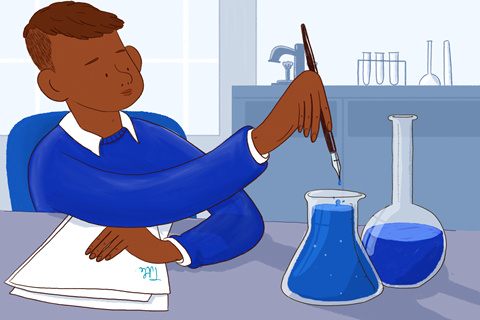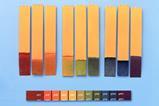Open questions, talking, scaffolding and editing can all improve writing – and ultimately students’ chemistry knowledge
We all wish our students were better at writing. Even those who are high achievers in their English lessons may struggle to translate that into success in chemistry.
Writing about chemistry is much more than just putting words on the page; ideas need to be communicated using correct scientific terminology and in logical sequences, avoiding repetition and contradiction. For this reason, writing about chemistry is a powerful tool for improving chemistry education for all. The writing process helps students reflect on their understanding, formulate new ideas and make links between ideas in new ways.

Changing writing culture
Students associate chemistry lessons with practical work and it is common for them to think they don’t need to do much writing in chemistry. This is purely cultural. Teachers and those involved in curriculum planning need to shape the chemistry curriculum to give sufficient opportunity for students to develop their writing. At my school we aim to have two opportunities for extended writing in each year group. One is a piece of technical writing, for example a report from an investigation they have carried out, and one piece of more active writing like a profile of a scientist or a controversial question like ‘Was Fritz Haber an evil genius?’ An open question where there is no correct answer can be liberating and challenging for high achievers. ‘What if …?’ is a useful question stem here; for example, ‘What if the periodic table was arranged alphabetically?’ or ‘What if crude oil wasn’t running out?’
7 simple rules to boost science teaching
Click to expand and explore the rules
Build on the ideas that pupils bring to lessons
Help pupils direct their own learning
Use models to support understanding
Support pupils to retain and retrieve knowledge
- Pay attention to cognitive load—structure tasks to limit the amount of new information pupils need to process
- Revisit knowledge after a gap to help pupils retain it in their long-term memory
- Provide opportunities for pupils to retrieve the knowledge that they have previously learnt
- Encourage pupils to elaborate on what they have learnt
Use practical work purposefully and as part of a learning sequence
Develop scientific vocabulary and support pupils to read and write about science
Use structured feedback to move on pupils’ thinking
Making extended writing accessible
Oracy is a key factor in supporting writing; students struggle to write what they cannot say. Pairing students up where one student says their answer and the other takes notes, concentrating on the keywords, is a good strategy here. These notes can then be used to form the written answer. This strategy works particularly well for practising writing responses for six-mark exam questions.
Writing at any great length requires both mental and physical stamina. Students may find either or both difficult. You will need to make adjustments for students with SEND like offering a laptop for extended writing. Similar adjustments may help overcome opposition from students who are reluctant writers. Extended writing is also best done in a quiet, even silent environment. Distractions can easily break a student’s concentration and result in a lack of fluency and logic in their writing.
Overcoming the activation energy of the blank page
A blank page is very intimidating for students who don’t find the writing process comes naturally. To overcome this barrier, provide suitable scaffolding for the writing process. It is a rare child (or adult) who can spontaneously write logically and clearly without first planning.
Writing frames have been the traditional way of scaffolding and recently I have become aware of structure strips. Structure strips are paper strips approximately the same width as the margin of an exercise book. They provide prompts for writing; the student sticks the strip into their exercise book and writes alongside it. Using structure strips students can effortlessly produce an A4 page of writing.
Everyone needs an editor
Students are novice science writers so they will make mistakes. Some of those may be in ‘secretarial’ literacy; mistakes in spelling, punctuation and grammar. Peer editing is a good strategy for this; it is much easier to spot spelling mistakes in someone else’s handwriting than in your own. Errors in scientific language will need teacher input, whether that is going through a mark scheme for students to self-assess or through marking yourself.
This article is part of the series 7 simple rules for science teaching, developed in response to the EEF’s Improving secondary science guidance. It supports rule 6d, Support students to develop their scientific writing skills.
Downloads
Structure strips for rates of reaction
Word, Size 52.92 kbStructure strips for rates of reaction
PDF, Size 45.95 kb















No comments yet